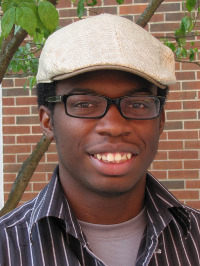2015 SRE Program Participant Profile: TALON JOHNSON
 |
Hometown: Dallas, TX |
Why did you apply to the SRE program?
I applied to this SRE program because I have always wanted to get a feel of interdisciplinary research and to get a feel for what graduate school might be like and if I really want to pursue a Ph.D. in the future. This program really seemed to have some fantastic qualities for anyone in the STEM field.
What is the purpose of your research?
The purpose of my research is to model the interactions between host cells and pathogens invading them. Both host and pathogen quarrel over nutrients and other resources in order to grow, live, and function. Hosts can fight back these invasive pathogens, like Blastomyces dermatitidisi, through non-specific immune stressors, though basic questions of these mechanism have been ignored. We plan to investigate these non-specific immune response stressors that not only affect and harm the pathogen but the host itself as well in order to secure the host's safety.
Describe a typical day on the job.
A typical day on the job consists of researching new material, coding, and analyzing data in order to help improve the model we are trying to develop. My group and I meet with our mentors at least once a week. There are some times when we are overwhelmed and things may not work according to plan, but collaborating with a team is beneficial and makes the job less taxing.
![]()
This program has given me insight into whether graduate school is for me, and I'm happy to say that I'm ecstatic for graduate school and pursuing a Ph.D. in biostatics.
![]()
– Talon Johnson, SRE participant
Tell us something about your field of study we would be surprised to know.
Modeling infectious diseases requires many parameters and ordinary differential equations to accurately illustrate the biology behind the model. Be prepared to go back to the drawing board.
What new experiences did you gain that have helped you today?
I believe the most valuable experiences have been coding/programming in R, collaborating with others from different fields of study, and learning how to read research articles and dissect the most relevant information about the research I'm conducting.
What advice would you give someone who's interested in/curious about participating in the program?
I would say that be prepared to get ready to work and meet the expectations given to you on day one. Also, you will meet amazing people from distant places, different personalities and skills. Have some fun too!
Would you recommend our program to others?
I definitely recommend this program because it gives undergraduates or post-undergraduates the opportunity to do research in the STEM field, and it really gives an insight if doing research and pursuing a PhD is the route one wants to take.
Where do you see yourself in 10 years?
This program has given me insight into whether graduate school is for me, and I'm happy to say that I'm ecstatic for graduate school and pursuing a Ph.D. in biostatics. I see myself in the future doing research in modeling infectious disease, specifically sexually transmitted diseases. Eventually, I would like to be a professor at a college or university and help a new generation reach their goals in the STEM field.
Related Links
Main SRE page
2015 summer program
NIMBioS
1122 Volunteer Blvd., Suite 106
University of Tennessee
Knoxville,
TN 37996-3410
PH: (865) 974-9334
FAX: (865) 974-9461
Contact NIMBioS


